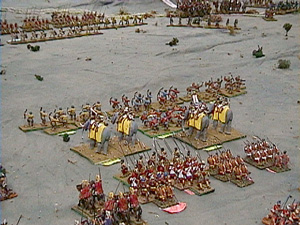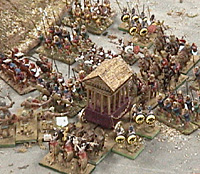 I had the pleasure of running two events at Fall-In held in November of
2000. I based them on the battle for the Hellespont in 321 BC as described
by Diodorus. Basically, Eumenes was sent there by Perdiccas to prevent
Craterus from heading south and helping Ptolemy stop Perdiccas. Eumenes
hurried north to collect and train an army but had insufficient time and so
ended up with less qualified infantry than what Craterus was bringing over.
Since he was recruiting in Cappadocia though, he was able to gather more
cavalry than Craterus.
I had the pleasure of running two events at Fall-In held in November of
2000. I based them on the battle for the Hellespont in 321 BC as described
by Diodorus. Basically, Eumenes was sent there by Perdiccas to prevent
Craterus from heading south and helping Ptolemy stop Perdiccas. Eumenes
hurried north to collect and train an army but had insufficient time and so
ended up with less qualified infantry than what Craterus was bringing over.
Since he was recruiting in Cappadocia though, he was able to gather more
cavalry than Craterus.
Both generals decided to line up their infantry in the center and have cavalry on the wings. This was standard Alexandrian tactics, however they were somewhat impetuous and ran ahead of the infantry lines. Craterus was thrown from his horse and trampled to death which caused his wing to retreat back behind the infantry. On the other side of the field, Eumenes grappled with Neoptolemus and killed him, which caused that wing to retreat as well. Craterus' infantry seeing their wings stripped bare, raised their pikes and surrendered.
I set up the battle for Fall-In pretty much like the historical description. I gave Eumenes a until of light cavalry and heavy cavalry for each wing. Craterus had to make do with one heavy cavalry unit and one light cavalry unit. He did have overall a much better line of heavy infantry and boasted a couple of units of peltasts that Eumenes did not have at all. The field was nice and flat but had a couple of low hills on each side which the armies anchored their wings on. A few woods were beyond the hills on either side.
First Game
In my first game, I played Eumenes against Bob Kerstetter's Craterus. He opened well by pushing his superior line forward. I tried to keep my skirmishers in the way to slow their progress. Meanwhile I sent my left flank light cavalry up against his right flank heavy cavalry to see if they might not soften up Craterus and his Companions. I learned that that was NOT a good idea as the light cavalry vaporized in the charge. At the same time though, I threw out my right flank light cavalry on a very wide arch around Craterus' left flank.
This move was feasible because of the high movement rate of the light cavalry. I kept my heavy cavalry unit on the same flank in formation and ready to move. It was a gamble because by pushing out the light cavalry I was giving Craterus something to worry about, but it took time moving them and I watched fretfully as his phalangites tore into my line and basically bowled them over. I did have a few units of better trained phalangites that I kept in a second reserve line and I threw them in to shore up the weakest point.
Meanwhile, Craterus was doing the right thing and curving his left flank back to guard against a charge from my light cavalry. After some time had passed, he move up his peltasts and hypaspists to hold his wing against my heavy cavalry. He chose then to turn his light cavalry unit around to deal with my unit which was now nearly behind his army. In this maneuvering, his line got a little out of order and a small hole opened. My heavy cavalry being A-class Companions had enough training to be able to change their formation to enter column and pour through the gap. Reforming once the had made it through, their reentered battle formation and charged into the back of Craterus' cavalry. That wing vaporized.
At this point both of our infantry lines looked ratty, but mine still held thanks to the second line being committed. I could turn around both of my cavalry units on the left wing now and chew into the backs of his infantry. With my left wing still possessing a strong heavy cavalry unit to hold that wing, Craterus knew the battle was over. It was a beautiful thing.
Second Game
 In the second game I ran, I was the judge and had two players to each
side. Dave Ferris played the second-in-command on Eumenes side, running the
left wing and skirmishers, while Mike Sarno played Craterus on the opposite
side. Mike is a savvy player and knew pretty well what he had to do to win
this battle and spared no time to get his heavy infantry line charging by
the second turn. Meanwhile he drove his right wing cavalry up on the
anchoring hill to get a commanding presence there. His second in command
decided to detach the commander from his light cavalry unit and attach him
to the peltasts instead. I think this was because he wanted more success on
the infantry push forward, however it would have serious repercussions to
the endgame.
In the second game I ran, I was the judge and had two players to each
side. Dave Ferris played the second-in-command on Eumenes side, running the
left wing and skirmishers, while Mike Sarno played Craterus on the opposite
side. Mike is a savvy player and knew pretty well what he had to do to win
this battle and spared no time to get his heavy infantry line charging by
the second turn. Meanwhile he drove his right wing cavalry up on the
anchoring hill to get a commanding presence there. His second in command
decided to detach the commander from his light cavalry unit and attach him
to the peltasts instead. I think this was because he wanted more success on
the infantry push forward, however it would have serious repercussions to
the endgame.
Dave did a good job with his skirmishers knocking a few hits in here and there. Things were going to get quite ugly for him though and he was very close to entering the "book of infamous gamers". He decided to move his light cavalry up the hill to meet Craterus. They stopped short of one another and then charged on the next turn. It was grim with the light cavalry routing but they did manage to take out nearly half of the heavy cavalry as well. Stunningly though, Craterus was thrown from his horse and trampled in the mayhem - Mike had rolled that his commander had died!
The party didn't end there though because when the light cavalry routed, Mike decided to pursue and this is where Dave was sweating some heavy bricks because he had left his heavy cavalry unit on an angle, poised to charge into the infantry line, but at the same time presenting a sweet flank to the hill wherefrom Mike was now charging down in sheer rage. The units collided and melee ensued and whatever gods Dave had offered to that day must have heard his prayers because he did not lose a single figure. It was just as stunning a result as the loss of Craterus. Mike's unit at that point dissolved.
Craterus' infantry though were going reckloose through Eumenes' men. It was amazing to see how a one morale class difference could make such a telling difference on the field. Training pays off. The Eumenes commander made a mistake in my opinion by not committing his second reserve line of better phalangites until it was too late.
He had moved his light cavalry out like I did earlier, but in this case he used them against the light cavalry of Craterus and got them to rout off the field. He moved his hypaspists up against the peltasts on Craterus' left wing and that was a melee certainly won by outclassing the opponent. They routed soon enough and what was bad about this was that the second-in-command was attached to them. With his heavy cavalry in a position to pursue, the players decided that sooner than later, they would be annihilated and either the commander killed or run off. In other words, with both commanders out of the picture, Craterus army surrendered. As Mike said earlier, a completely historical result!
Comments and Conclusions
 In the second game I think all participants of both games had a good time. It was a great
scenario that seemed balanced but with different army flavors to make it
interesting. I think I might cut down the amount of heavy cavalry Eumenes
had on the left wing from 9 figures to 6. Upon reflection, I think I gave
too much to the army based on the historical source and it certainly would
help balance the battle a bit.
In the second game I think all participants of both games had a good time. It was a great
scenario that seemed balanced but with different army flavors to make it
interesting. I think I might cut down the amount of heavy cavalry Eumenes
had on the left wing from 9 figures to 6. Upon reflection, I think I gave
too much to the army based on the historical source and it certainly would
help balance the battle a bit.
These battles were a good learning experience for the Ancient player. Very often you hear how battles were won because wings of cavalry were stripped from the line. The early Roman armies suffered this problem often. Here the problem was clear: the more numerous cavalry units could strip away the opposing units faster than the opposing main line could break through and then perform flanking maneuvers. Clearly it would be best for Craterus to delay any action on the wings for as long as possible to give his infantry enough time to perform the breakthrough. I think that if I allowed Craterus a free set-up he might put all his skirmishers around the wings rather than along the main battleline, so that they could strengthen the sides and basically buy the heavy infantry more time to fulfill their role. Worth running the game again to try and see if Craterus can win.
Of course, considering how important personality was to lead troops during this time period, keeping your commanders from getting killed is another "good thing". But many times, as Mike found out, Fortune has more say in that than you do.
Note: Photos are from Norbert's ancient campaign at the JodieCon convention.--RL
Back to War Lore: The List
Back to Master Magazine List
© Copyright 2000 by Coalition Web, Inc.
This article appears in MagWeb (Magazine Web) on the Internet World Wide Web.
Other military history articles and gaming articles are available at http://www.magweb.com